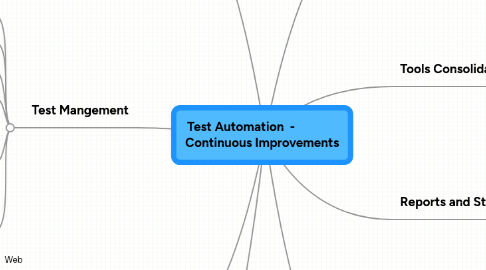
1. CI and CD
1.1. Plan Branches
1.1.1. MAIN branch, which is the GOTO production like copy
1.1.2. Strategy of retiring development branches when projects conclude
1.1.3. avoid duplication and better collaborated coding / automation
1.2. SVN
1.2.1. • Absolutely, no check-ins policy without reviews
1.2.2. • Always ensures checked-in code in SourceControl builds and is executable on demand
1.3. Daily Runs
1.3.1. Keeping it current (Making people trust (and rely on) results from the automated tests)
1.4. Make it part of definition of DONE.
2. Test Mangement
2.1. Clean-up
2.2. Xray Utilities
2.3. One-Click Quarantine
2.3.1. Isolate tests that need maintenance
2.4. Agree on Definition of DONE
2.5. The review / sign-off process
2.5.1. Who the sign-off is obtained from (Viz BAs, Architects, DB Developers, UI Developers, Integration Developers etc.)
2.5.2. For which artefacts is the sign-off required …. Maybe perhaps just the BDD, to ensure
2.5.2.1. • Business coverage is achieved • Any special requirements that need focussing is captured and validated • Adequate boundary testing is achieved etc
2.6. Who makes tests current
2.6.1. Automated?
3. UpSkilling
3.1. Web
3.2. Integration
3.3. Thick Client
3.4. Mobile
3.4.1. Responsive Web
3.4.2. Apps
3.5. Shell Scripting
3.6. o On boarding process (for new starters)
4. Automation Standards
4.1. BDD Principles
4.2. Fully Automated Regression Suites
4.3. Code to the Requirements - Prioritize
4.4. 20-30-50% GUI-API/Integration-Unit
5. Coding Standards
5.1. Peer Reviews
5.1.1. before check-ins
5.1.2. Absolutely, no check-ins policy without reviews
5.2. Exception Handling
5.3. Error Logging
5.4. Documentation
5.4.1. • Requirements covered by a test, and up to what point (a date) • What is too little or too much, being meaningful in generic comments • Comments describing special needs of the test or performance implications or external interface requirements • Data requirements if its trivial
5.5. Naming Conventions
5.5.1. • Tests, support / framework Classes, Methods, Properties etc
5.6. Design techniques
6. Tools Consolidation
6.1. o Evaluation and association of new software libraries /techniques
6.1.1. Could be an Assertion library Could be a the next new version Selenium…. Etc….
7. Reports and Status
7.1. Aggregated Test Results
7.2. Frequency Of Test Execution
7.3. Reusability
7.4. Complexity
7.4.1. Technical Feasibility
7.5. Execution Time
7.6. Automation Coverage
7.7. o ROI for Automation
8. Frameworks
8.1. Function/Module Script Reusability
8.2. Ease Of Use
8.3. Report Customization
8.4. Maintainance
8.4.1. BUG fixes (Production Systems as well as Automated Frameworks / Tests)
